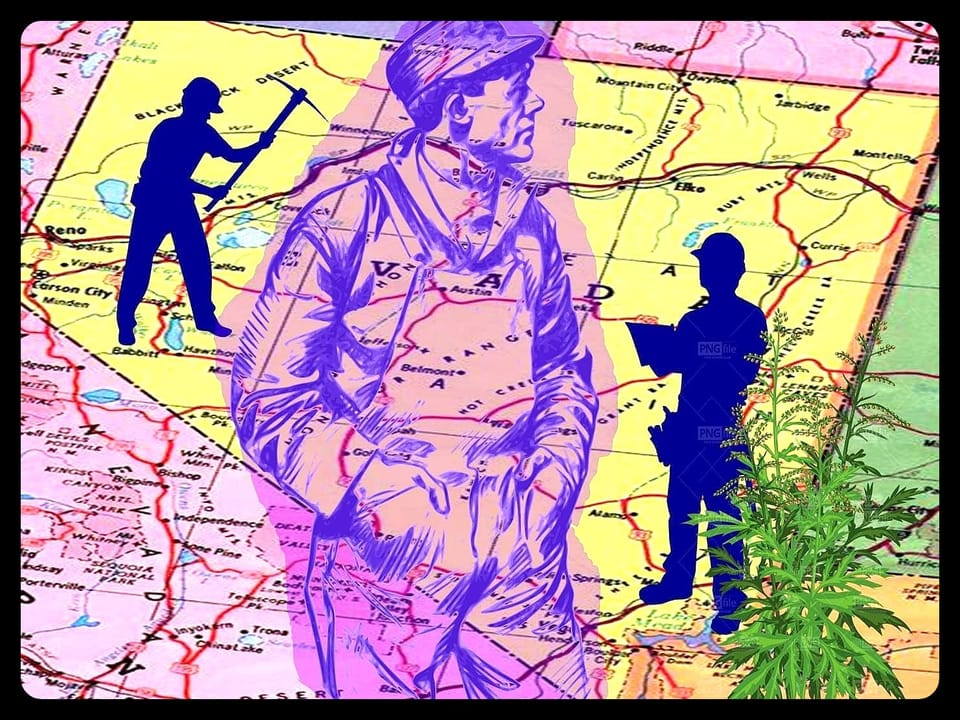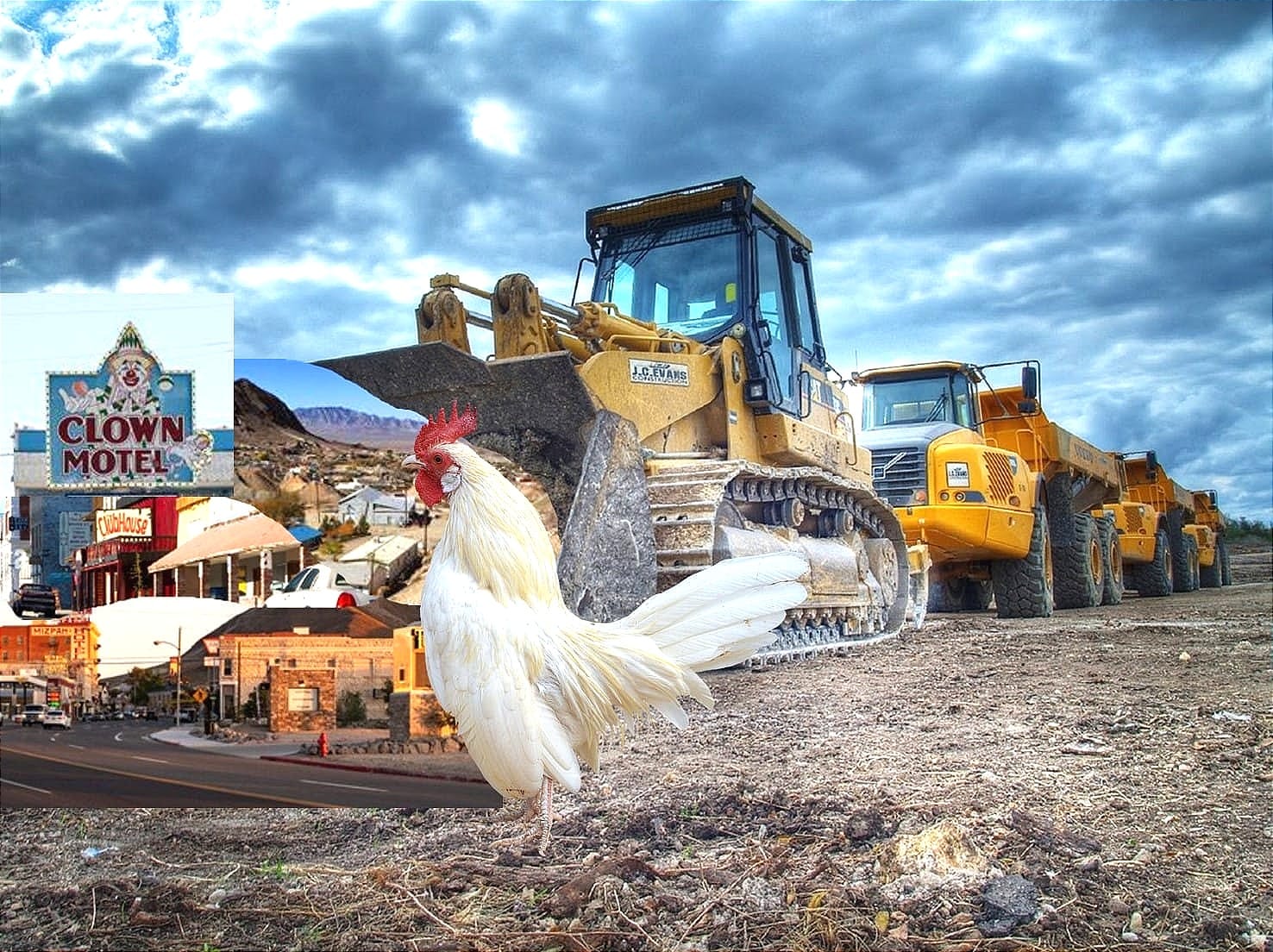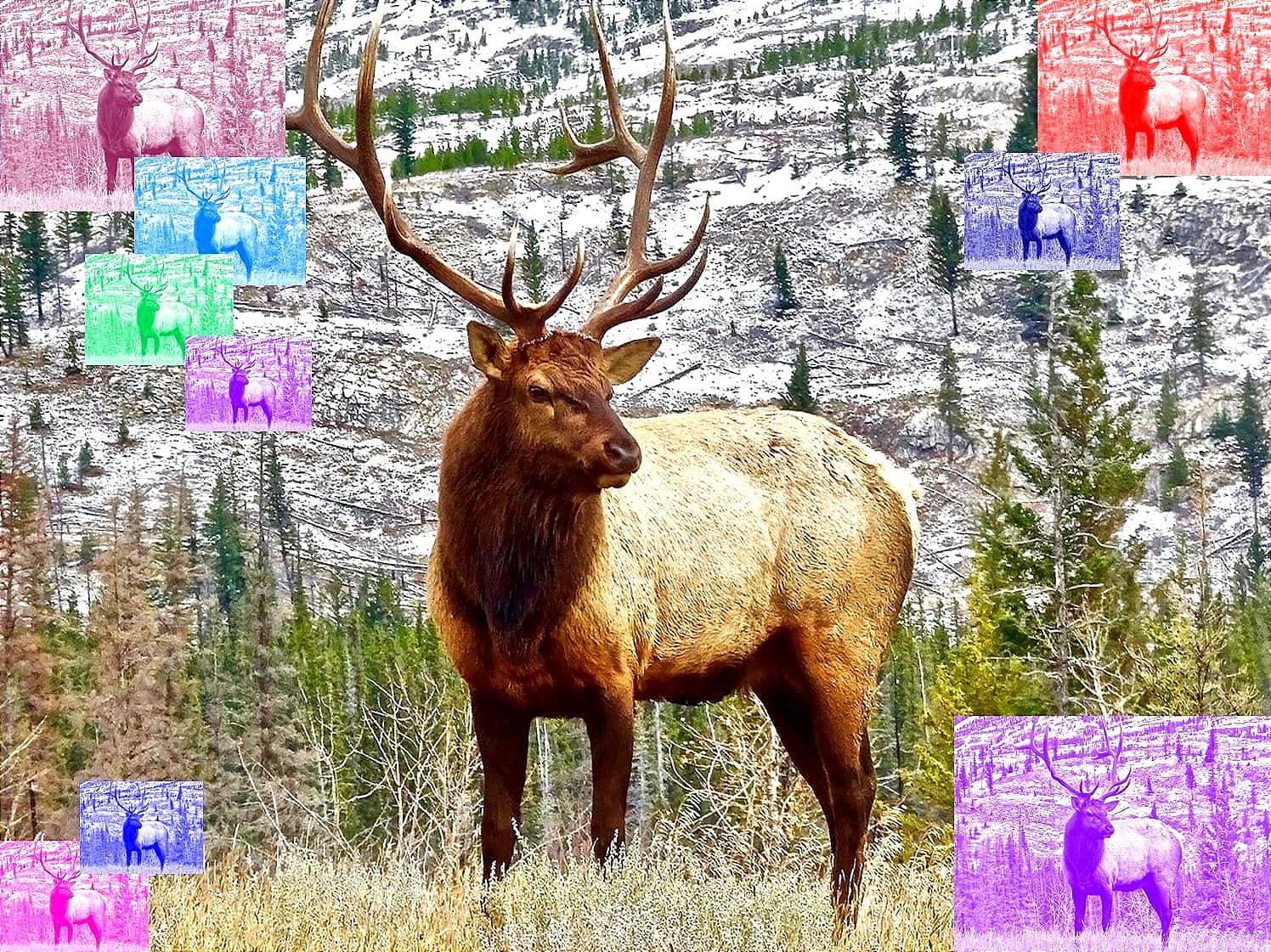Chronic Wasting Disease, Lithium Mining, and the Clown Motel: A Journey through Tonopah, Nevada

Halfway between Reno and Las Vegas, the small mining town of Tonopah, Nevada serves as a point of rest, a stop for travelers heading south for the winter or north for the months of summer. Little did I know that something remarkable awaited me in the pages of its history.
Rising above desert mountains, the RV park and truck stop were a welcome sight as I beheld their silhouette in the distance. At the time of my arrival, I sought no more than the beauty of a Southwestern sunset and a night of rest. However, I found myself in the midst of something fascinating, a mining town--with a motel dedicated to clowns--and the acquaintance of a wildlife biologist, a young scientist studying the emerging horror of chronic wasting disease. As it turned out, I spent nearly two weeks there, appreciating distant mountains and recovering from my previous journey--nine hours driving from Bend, Oregon to Reno, and a long stretch through the desert to Tonopah.
The main RV park of the region, where I resided as the chilly nights of autumn advanced, contained a number of apartment buildings, presumably occupied by laborers in residence. Curious about this arrangement, I spoke to the park's manager who described leasing the units to a single corporation for nearly two years. And what is the nature of corporate activity in the region? Let's begin with an article from the Pahrump Valley Times that puts the matter into perspective. In "Lawsuit Alleges BLM violated Endangered Species Act in Approving Lithium Mine" (November 4, 2024) Alan Halaly states:
A week after the Bureau of Land Management approved Nevada’s third lithium mine, environmentalists and a Western Shoshone group filed a lawsuit alleging that the agency rushed the environmental review process and violated federal laws.
The lawsuit, filed in U.S. District Court Thursday, is the latest in a long line of challenges to a lithium-boron mine proposed in rural Esmeralda County by Ioneer, an Australian mining company. The company says its mine, located miles away from the country’s only lithium mine in the Silver Peak Mountain range, would produce enough lithium to power 370,000 electric vehicles every year.
The imagery here, though straightforward, is remarkable in its detail, a procession of compact cars, perhaps decorated by familiar logos, winding through streets that once possessed the character and roaring noise of gasoline engines. But I digress.
Sadly, the scenario narrated above sounds quite familiar, an ongoing saga of large-scale mining operations erupting unchecked. At present, relentless business ventures continue to strip our environment to its depths, all to provide manufacturers with natural resources, electric vehicles and solar panels requiring considerable amounts of lithium. So, we follow the trail of money and learn much about the nature of things. John Hadder, the director of Great Basin Resource Watch, had this to say:
The end use of minerals, whether for EV’s or solar panels, does not justify this disregard of Indigenous cultural areas and keystone environmental laws. Approval of this mine risks rolling back standards of protection and advancing an era of relaxed mine permitting that we and future generations will seriously regret.

As of this writing, the BLM has yet to respond. And what is the commercial perspective on the matter? American Lithium Corporation, yet another mining interest with designs on Tonopah, stated the following in their project overview:
The TLC Project is a near-surface “Made in America” lithium deposit – one that is amenable to low-cost, sustainable mining methods. Studies show that no protected plant or wildlife species are impacted by our operations.
The project itself is also located near the regional hub and county seat in the town of Tonopah, Nevada. Logistics (paved roads, power, etc.) are superior for development and water resources are not constricted as at Clayton Valley. (1)
Fire, Anyone? (Lithium-Ion Batteries in Perspective)
Apart from the considerable damage mining operations cause to the environment, there remains the question of product safety, the extent to which lithium-ion batteries should be used in vehicles and electronics. In short, because of a phenomenon called thermal runaway, related to the chemical composition of the batteries, excessive heat can build within them. When this takes place, the units can melt or, in some cases, even explode and cause chemical fires. With electric vehicles, there is much more to consider, as Patrick Durham (Captain and Training Officer in the Troy Fire Department of Michigan--and mechanical engineer) makes clear in his work.
In his video, "Electric Vehicle Fires: Frequency vs Severity," Durham explains that engineers and firefighters examine the subject of frequency and severity in much the same way, with the former conducting failure modes and effects analysis (FMEAs) to understand the criteria involved with the failure of devices under examination. With the aid of complex spreadsheets, engineers try to determine the frequency and likelihood of failures, while, at the same time, attempting to predict the severity of such events. Engineers, as well as firefighters, are concerned with the severity of lithium-ion battery fires, compared to the more frequent gasoline fires faced by the latter.

Durham goes on to state that "tens of thousands of gallons of water" are needed to extinguish an electric vehicle fire. Now, when we consider additional hazards, like the floodwaters that sometimes cause lithium batteries to ignite after hurricanes, the feasibility of EVs seems questionable, at best. And what are the risks?
In the Consumer Affairs Journal of Consumer Research (July 25, 2024) Sean Golonka stated that EV fire stats in the U. S. are limited. However, in 2022, EVs only made up 0.9% of vehicle registrations. Also in 2022, the MSB Report in Sweden stated that internal combustion engine fires occurred 20 times more often than EV fires. And yet, the severity of the latter--requiring tens of thousands of gallons of water--cannot be overstated. Moreover, EV manufacturing fires, as well as questions about the disposal of old batteries, indicate that this "green" industry is anything but environmentally friendly and sustainable. Corporate greed, anyone?
As for the basics of this fascinating subject, we can learn much from Batteries for Electric Vehicles: Materials and Electrochemistry by Helena Berg. Her book details everything from battery composition and electrochemistry to the uses of different cell designs. For those who wish to conduct further research, and learn more about this technology, I will include a list of additional resources at the end of this piece. Suffice it to say, the subject of lithium-ion battery fires is concerning in its implications for the future.
Despite environmental damage and social injustice, lithium mining and battery production will likely remain with us, blighting the landscape with an array of toxins. And, yes, money is at the root of things, with the shadow of greed covering any hint of ethics. Will regulatory measures be taken to correct things? Time, as is often the case, will tell.
Nevada's Historic Mining Park

Tonopah is no newcomer to mining, as the town began to flourish in 1900 with the extraction of silver ore, eventually being dubbed "Queen of the Silver Camps." Today, intrepid visitors can explore the Tonopah Historic Mining Park, where, in the company of locals (or equipped with a self-guided tour brochure) they can learn about Jim and Belle Butler, the power couple whose mining claim has become legendary.
Born Isabella McCormick in Nova Scotia around 1860, Belle, as she was commonly known, married 39-year-old Maurice Donohue when she was 16 and began the adventures for which she would be remembered--and scandalized. The couple had three children and suffered through marital issues, as Donohue grew abusive and suspicious of his wife, and she sought the affections of rancher Jim Butler. In dramatic fashion, Butler eventually killed Donohue and became Belle's next husband, giving locals more than a little inspiration for gossip. As for the town, Butler decided on the Shoshone name of Tonopah to identify his mining claim. (2) Today, the mining park tells the story of these odd characters, the prospectors who wrote a small Nevada town into the pages of history. And, rather happily, curators have done a wonderful job in presenting the details of their venture.
With restored mining equipment, buildings, and exhibits, the park preserves the history of four original mining companies and encompasses nearly 100 acres. (3) As for the interpretive materials available to the public, their tone is uncritical and discretely avoids the controversy of mining endeavors. The underground portion of the tour, however, allows visitors to experience the working conditions endured by miners, those perilous spaces that consumed the strength of so many men. Today, in the face of lithium mining, many of the old issues remain and call out for resolution.
The Hypocrisy of "Green" Energy
As the government bows to corporate influences, and the environment of a small town hangs in the balance, we see a familiar pattern; a narrative of greed unfolds throughout communities across the world, the oligarchs of industry consuming vast acres of habitat in the name of sustainability. On November 9, 2024, APTN National News of Winnipeg reported on the issue of resource extraction on traditional lands. During the month of October, indigenous people from various parts of the world met in Geneva, Switzerland to contest a new iteration of age-old mining practices.
Under the banner of green or sustainable projects, corporations continue to devour swathes of the environment, as if no one will notice their glaring hypocrisy or hold them accountable. Indeed, as corporations extract resources from indigenous lands, in the name of "clean" or "renewable" energy, they often do so in the absence of consent or communication with inhabitants. (4) And the damage they inflict is comparable to that of non-renewable projects, adding insult to injury in the most extreme manner.
In 2024, as controversy looms, Tonopah, Nevada is very much at the forefront of the mining world. However, there is another issue which bears consideration, as we turn our attention to nature and the many perils confronting the lands we share.
Shadows of the Age: Chronic Wasting Disease

It happened that one of my neighbors at the RV park was a young scientist, residing briefly in Tonopah to conduct research on CWD. We spoke on a few occasions, and he loaned me a stack of public outreach materials to review, mainly comprised of information for hunters, a group whose assistance is essential for monitoring efforts. In short, chronic wasting disease (spongiform encephalopathy) is likely caused by prions.
A fatal neurological infection, it impacts cervids, including deer, elk, and moose, causing brain damage and emaciation prior to death. The prions responsible for the disease can be spread among the animals and remain viable within the environment for years, this according to Dr. Mayank Saxena. More information can be found on the CDC website. We are told by them, as well as other health authorities, that the disease does not pose a threat to humans--although the consumption of infected meat should be avoided, and hunters are encouraged to exercise care when field dressing their harvests.
My neighbor expressed more concern than the CDC regarding the matter, citing the unprecedented nature of the illness. At the moment, few projections can be made, and contention remains about the potential threat to humans. To anyone who has seen footage of emaciated animals running in circles, or crashing into obstacles, the situation has an ominous aura and speaks of darker days to come.
As the Bureau of Land Management steps aside and welcomes corporate mining operations into Tonopah--and the specter of a wasting disease threatens an already burdened ecosystem--one cannot help but wonder about the future, not just the prospects of Nevada but the situation for the entire country.
Now, as we end our brief tour of historical Tonopah, we must make a final stop, a visit to a peculiar landmark painted with eyes of exuberance and a rather disquieting smile.
The Clown Motel
Although promoted as "the scariest motel in the world,"--there's just something about clowns, I suppose--it seems fairly nondescript, apart from 31 rooms of distressing decor. On a sunny autumn afternoon, the RV park manager gave me a driving tour of Tonopah and mentioned that the motel had a more mundane beginning than the sign suggests.
In 1985, the children of Clarence David opened the motel and featured their father's prized clown collection as its central theme, 150 pieces of ephemera with a less than creepy provenance. Davis had died in the 1942 Belmont Fire, and his children wished to memorialize him. Over the years, various owners have left their mark on the establishment, rendering it another desert oddity, attracting film crews and travelers who pass through en route to Las Vegas.
For my part, I found the Clown Motel to be charming and eccentric, situated among various structures of historical relevance, flourishing in the shadow of social and ecological drama.
And here ends my trip to Tonopah, Nevada, another stop along the way, fascinating and possessed of countless stories. Perhaps I'll return one day for further explorations. I thank you for joining me.
Works Cited:
(1) American Lithium Corporation (americanlithiumcorp.com)
(2) Nevada Women's History Project (NWHP) (nevadawomen.org)
(3) Tonopah Mining (tonopahminingpark.com)
(4) APTN National News (aptnnews.ca)
For Further Reading:
(Lithium Mining and Batteries)
Siddharth Goel (Et Al) What Are Lithium Mining Companies Looking for? International Institute for Sustainable Development (IISD) (2023)
Goldman, Abby R. (Et Al) Lithium Ion Battery Industrial Base in the US and Abroad, Institute for Defense Analysis, December 1, 2019
(Electric Vehicles)
Heitkamp, Kristina Lyn. Electric Vehicles (Lake Elmo, Minnessota: Focus Readers) 2022.
David A. Kirsch and Gijis P. A. Mom. "Visions of Transportation: The EVC and the Transition from Service- to Product-Based Mobility" (The Business History Review, Vol. 76, No. 1 (Spring, 2002), pp. 75-110.
James Larminie and John Lowry. Electric Vehicle Technology Explained. (Hoboken, New Jersey: John Wiley & Sons) 2012.
Spellman, Frank R. The Science of Electric Vehicles: Concepts and Applications. (Boca Raton, Florida: CRC Press) 2023.
(Chronic Wasting Disease)
Mawdsley, Jonathan R. "Phylogenetic Patterns Suggest Broad Susceptibility to Chronic Wasting Disease Across Cervidae" Wildlife Society Bulletin (2011-), Vol. 44, No. 1 (March 2020), pp. 152-155.
U.S. Geological Survey
What is chronic wasting disease?
Chronic wasting disease (CWD) is a fatal, neurological illness occurring in North American cervids (members of the deer family), including white-tailed deer, mule deer, elk, and moose. Since its discovery in 1967, CWD has spread geographically and increased in prevalence locally. CWD is contagious; it can be transmitted freely within and among cervid populations. No treatments or vaccines are currently available.
Chronic wasting disease is of great concern to wildlife managers. It has been detected in at least 23 states, two Canadian provinces, and South Korea. CWD is not known to infect livestock or humans.
CWD is transmitted directly through animal-to-animal contact, and indirectly through contact with objects or environment contaminated with infectious material (including saliva, urine, feces, and carcasses of CWD-infected animals).
(Clowns and Related Cultural Contexts)
Amoore, Louise. "The Clown at the Gates of the Camp: Sovereignty, Resistance, and the Figure of the Fool" (Security Dialogue, Vol. 44, No. 2 (April 2013), pp. 93-110).
Bala, Michael. "The Clown: An Archetypal Self-Journey" (Jung Journal: Culture & Psyche, Vol. 4, No. 1 (Winter 2010), pp. 50-71).
Charles, Lucile. "The Clown's Function" (The Journal of American Folklore, Vol. 58, No. 227 (Jan. - Mar., 1945), pp. 25-34).